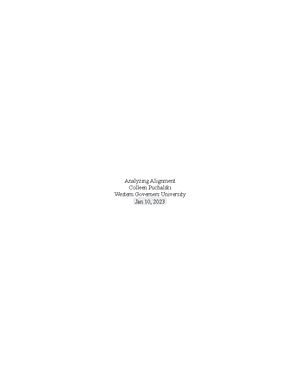

Curriculum Instruction and Assessment
Coursework
Curriculum Instruction and Assessment
Practice materials
Curriculum Instruction and Assessment
Coursework
Curriculum Instruction and Assessment
Assignments
Curriculum Instruction and Assessment
AssignmentsLesson Title: Rainforest Animals Subject(s): English Language Arts (ELA) Grade/Level/SeAng: 1st grade classroom Prerequisite Skills/Prior Knowledge: What do your students already know or what do they need to know about the selected topic to successfully participate in the lesson?
Prior to this lesson, students will need the foundations for reading in English, following classroom discussion protocols, and
State/Na'onal Academic Standard(s):
RF.1 Know and apply grade-level phonics and word analysis skills in decoding words. RF.1 Read with sufficient accuracy and fluency to support comprehension. RF.1 Read on-level text with purpose and understanding. RF.1 Use knowledge that every syllable must have a vowel sound to determine the number of syllables in a printed word. SL.1 Produce complete sentences when appropriate to task and situaGon. SL.1 Follow agreed-upon rules for discussions. SL.1 Ask and answer quesGons about key details in a text read aloud or informaGon presented orally or through other media.
Learning Objec,ve(s): Identify what students will accomplish by the end of the lesson; these need to align with the state or Common Core State Standards and need to be measurable (condition, behavior, and criterion).
Students will be able to (SWBAT): Identify the diagrams /ur/ Create sentences with grade-level appropriate texts
What materials will the teacher and the students need in order to complete the lesson? Texts- 1 Home For Bats 2 Kapok Tree 3 Lion and the Mouse
Accordion books SMART board for creaGng a graphic organizer Clip of the Rain Forest Song Rainforest sound and video clips Tablets/laptops Pencils for students Vocabulary cards
How will you use technology to enhance teaching and learning? (Optional: Use the SAMR model to explain the technology integration strategies you plan to use.)
Student will be using the SMART board to help create our Know-Wonder-Learn chart. Video and sound clips of the Amazon rainforest will be played for students to get a feeling for the physical environment of the rainforest. The vine of knowledge will be completed digitally on tablets through Evernote.
Specific ways that academic language (vocabulary, functions, discourse, syntax) is used by students to participate in learning tasks through reading, writing, listening, and/or speaking to demonstrate their understanding. Language Func,on(s): The content and language focus of the learning task represented by the active verbs within the learning outcomes. Common language functions include identifying main ideas and details; analyzing and interpreting characters or events; arguing a position or point of view; or predicting, recording, and evaluating data. Common language functions in math include predicting from models and data, recording multiple ways to solve problems, justifying conclusions, evaluating data, and explaining how or why certain strategies work.
Identifying main ideas and key details Character analysis Predicting the day’s activities Vocabulary: Include words and phrases that are used within disciplines, including (1) words and phrases with subject-specific meanings that differ from meanings used in everyday life (e., table), (2) general academic vocabulary used across disciplines (e., compare, analyze, evaluate), and (3) subject-specific words defined for use in the discipline.
Murmured, furry, churn, scurry, urgent, hissed, slithered, scales, ruins.
Discourse and/or Syntax: Discourse includes the structures of written and oral language, as well as how members of the discipline talk, write, and participate in knowledge construction. Syntax refers to the set of conventions for organizing symbols, words, and phrases together into structures (e., sentences, graphs, tables).
The first porGon of the lesson will be full class discussion. Later, students will answer guided reading ques Gons in full sentences. Students will also collaborate on a Know-Wonder-Learn chart. They will create accordion books and a vine of knowledge.
Planned Language Supports: This includes the scaffolds, representations, and pedagogical strategies teachers intentionally provide to help learners understand and use the concepts of language they need to learn within disciplines.
Fluency acGvity- teacher read 1 Gme, students pair and read 2 Gmes each Vocabulary- post and say target word, whisper to neighbor, tap out syllables, teacher provides definiGon, students turn and share definiGon, teacher gives example of how to use word.
Phonemic awareness- teacher read aloud words with /ur/ sound. Students will thumbs up or down if they hear the /ur/ sound.
Phonics- teacher will write /ur/ and say it’s sound, having students repeat. Then teacher will write words on the board, underlining the spelling paXern and modeling orally. Students will repeat and chorale blend the sounds.
Consider how to accommodate for the needs of each type of student. Be sure that you provide content-specific accommodations that help meet a variety of learning needs.
GiSed and Talented: Increased vocabulary and more challenging quesGons during small group reading. EL: Reading skill support during small groups. Students with Other Special Needs:
Forma,ve Describe how you will monitor, support, and extend student thinking.
I will ac'vate prior knowledge by asking my students ques'ons as I travel the classroom listening to their small group discussions. During our whole-class discussions I will be able to assess student comprehension and student phonemic awareness.
Summa,ve (Quizzes, tests, products)
Character accordion book. Vine of knowledge.